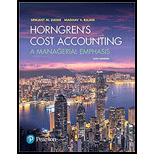
Concept explainers
Identifying and managing unused capacity (continuation of 12-21). Refer to Exercise 12-21.
- 1. Calculate the amount and cost of unused administrative capacity at the beginning of 2017, based on the actual number of customers Gianni served in 2017.
Required
- 2. Suppose Gianni can only add or reduce administrative capacity in increments of 250 customers. What is the maximum amount of costs that Gianni can save in 2017 by downsizing administrative capacity?
- 3. What factors, other than cost, should Gianni consider before it downsizes administrative capacity?
12-21 Strategy, balanced scorecard, merchandising operation. Gianni & Sons buys T-shirts in bulk, applies its own trendsetting silk-screen designs, and then sells the T-shirts to a number of retailers. Gianni wants to be known for its trendsetting designs, and it wants every teenager to be seen in a distinctive Gianni T-shirt. Gianni presents the following data for its first two years of operations, 2016 and 2017.
| 2016 | 2017 | |
| 1. Number of T-shirts purchased | 215,000 | 245,000 |
| 2. Number of T-shirts discarded | 15,000 | 20,000 |
| 3. Number of T-shirts sold (row 1 – row 2) | 200,000 | 225,000 |
| 4. Average selling price | $ 30.00 | $ 31.00 |
| 5. Average cost per T-shirt | $ 15.00 | $ 13.00 |
| 6. Administrative capacity (number of customers) | 4,500 | 4,250 |
| 7. Administrative costs | $1,633,500 | $1,593,750 |
| 8. Administrative cost per customer (row 7 ÷ row 6) | $ 363 | $ 375 |
Administrative costs depend on the number of customers Gianni has created capacity to support, not on the actual number of customers served. Gianni had 3,600 customers in 2016 and 3,500 customers in 2017.
- 1. Is Gianni’s strategy one of product differentiation or cost leadership? Explain briefly.
- 2. Describe briefly the key measures Gianni should include in its balanced scorecard and the reasons for doing so.
Trending nowThis is a popular solution!

Chapter 12 Solutions
EBK HORNGREN'S COST ACCOUNTING
- Nonearrow_forwardFinancial Accountingarrow_forwardMia Vision Clinic is considering an investment that required an outlay of $505,000 and promises a net cash inflow one year from now of $660,000. Assume the cost of capital is 13 percent. Break the $550,000 future cash inflow into three components: 1. The cost of capital. 2. The profit earned on the investment. (FINANCIAL ACCOUNTING)arrow_forward

 AccountingAccountingISBN:9781337272094Author:WARREN, Carl S., Reeve, James M., Duchac, Jonathan E.Publisher:Cengage Learning,
AccountingAccountingISBN:9781337272094Author:WARREN, Carl S., Reeve, James M., Duchac, Jonathan E.Publisher:Cengage Learning, Accounting Information SystemsAccountingISBN:9781337619202Author:Hall, James A.Publisher:Cengage Learning,
Accounting Information SystemsAccountingISBN:9781337619202Author:Hall, James A.Publisher:Cengage Learning, Horngren's Cost Accounting: A Managerial Emphasis...AccountingISBN:9780134475585Author:Srikant M. Datar, Madhav V. RajanPublisher:PEARSON
Horngren's Cost Accounting: A Managerial Emphasis...AccountingISBN:9780134475585Author:Srikant M. Datar, Madhav V. RajanPublisher:PEARSON Intermediate AccountingAccountingISBN:9781259722660Author:J. David Spiceland, Mark W. Nelson, Wayne M ThomasPublisher:McGraw-Hill Education
Intermediate AccountingAccountingISBN:9781259722660Author:J. David Spiceland, Mark W. Nelson, Wayne M ThomasPublisher:McGraw-Hill Education Financial and Managerial AccountingAccountingISBN:9781259726705Author:John J Wild, Ken W. Shaw, Barbara Chiappetta Fundamental Accounting PrinciplesPublisher:McGraw-Hill Education
Financial and Managerial AccountingAccountingISBN:9781259726705Author:John J Wild, Ken W. Shaw, Barbara Chiappetta Fundamental Accounting PrinciplesPublisher:McGraw-Hill Education





